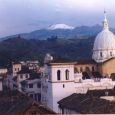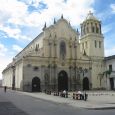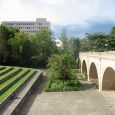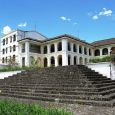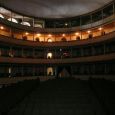Popayan
Advertisement
By Air
Popayan's airport does not have heavy traffic but you can reach the city by air.There are about four daily flights from Bogota to Popayan and vice versa.The airport is open between 6 AM and 6 PM (daylight hours).There are no flights between Cali and Popayan as of this writing (December 2008). The airport in the neighbor city of Cali (100 minute car ride) serves many domestic and international destinations.
By Train
unfortunately, Colombia no longer has a rail service to speak-of.Until the early 1970's you could still travel between cities like Cali and Popayan by rail, but the Colombian government let the national rail company go bankrupt. Sadly enough, many rail tracks were stolen for use in construction projects in rural areas.
By Bus
the bus from Cali to Popayan takes only two hours and there are numerous bus companies available.The most reliable are bus operators are Expreso Palmira and Expreso Bolivariano. Avoid Expreso Puerto Tejada.If you are in southern Colombia and traveling northwards, the bus from Pasto to Popayan takes about 4 to 6 hours. Be advised that there is significant guerrilla activity in the countryside near Popayan and it can be risky to travel by land during periods of disturbance if you are not a local. There are daily buses from the border town of Ipiales.
By Taxi
in Colombia it is common to travel by taxi between major cities.You can get on a shared cab at any major transportation terminal. If you want a cab just for yourself, you will need to pay a fare equivalent as if the cab was full.
Advertisement
El Morro de Tulcan
It is the main archaeological site of Popayan. It consists of a truncated pyramid built in prehistoric times, approximately between 500 and 1600 A.C., a period known as late chiefdom societies. In 1937 to commemorate the 400th anniversary of the foundation of the city, a monument was opened in 1937 at the top of the hill in honor of the founder of the city, Sebastián de Belalcázar, with an equestrian statue made by the Spanish artist Victorio Macho.
Francisco Jose de Caldas Auditorium
Better known as the Paraninfo, it is an imposing building of the mid eighteenth century and it was part of the monastery of the Dominican order until 1826. First, it was built with a mud and straw roof, then it was reinforced over the years with rammed earth and tile, until it became a colonial architecture expression again. Simón Bolivar declared it in 1827 as a property with historic heritage value , when it was already a two steps hose in front of the Santo Domingo plaza. The last great governor of Cauca, don Miguel de Arroyo Hurtado, made more renovations and reforms that gave it the most current look. When the building was handed over to the University of Cauca in the early twentieth century, several changes and additional extensions were made, which recovered all the original spaces.
Humilladero Bridge
It connects the center zone with the north zone of the city. It was built in 1873 on arches of brick and masonry, according to Italian religious Fray Serafin Barbetti designs and a German engineer whose mummified remains are preserved in the Archdiocesan Museum of Religious Art in the city. Between downtown and El Callejón neighborhood, now Bolivar neighborhood, there is a fault that before the bridge construction it was extremely difficult to go to downtown and due to this circumstance people rose almost on their knees. And that's why it was called Humilladero. For a long time this bridge was one of the main entrances to the city, the liberating armies entered through it during the gestation of Colombia independence. Its cool design and strong construction have allowed it to remain intact after many earthquakes.
House-Museum Mosquera
This house displays a very interesting collection of colonial art and precious memories of the Mosquera family. It works in the house that belonged to the Mosquera Arboleda family, a recognized family in the history of Colombia, whose members occupied the highest positions of political power, ecclesiastical, military and diplomatic, simultaneously during much of the nineteenth century. The most important were: Joaquín Mosquera, Tomás Cipriano de Mosquera, Manuel José Mosquera and Manuel Maria Mosquera. The father of them all, Jose Maria Mosquera y Figueroa, was considered by the Liberator Simón Bolívar as the only person he would choose as a second parent.
National Museum Guillermo Valencia
It is located in a mansion on the Próceres Street, and it is dedicated to the poet Guillermo Valencia, one of the most prominent members of Modernism in Spanish literature. Its numerous rooms are decorated with valuable works of art and artistic pieces, as well as a collection of hundred of selected books, diplomas, medals and awards that Master Valencia received for his distinguished political life and for its fine literary and poetic compositions. In the park located across the street it stands the statue of the poet, made by the Spanish sculptor Victorio Macho. It has too a family cemetery where the remains of several generations of Valencia are resting.
San Francisco Church
According to the architect, critic and historian Germain Téllez, the facade of this temple is the best example of baroque style throughout Colombia. In its tower is placed a famous bell donated by Don Pedro Agustín de Valencia. This temple is remarkable because of its altars decorations and its naves and apse proportions. In the San Francisco's square, it stands the monument to the local hero Camilo Torres, whose replica is located in the square of the Colegio Mayor de San Bartolomé in Bogota.
September - December
May - August
Information not available
Advertisement

